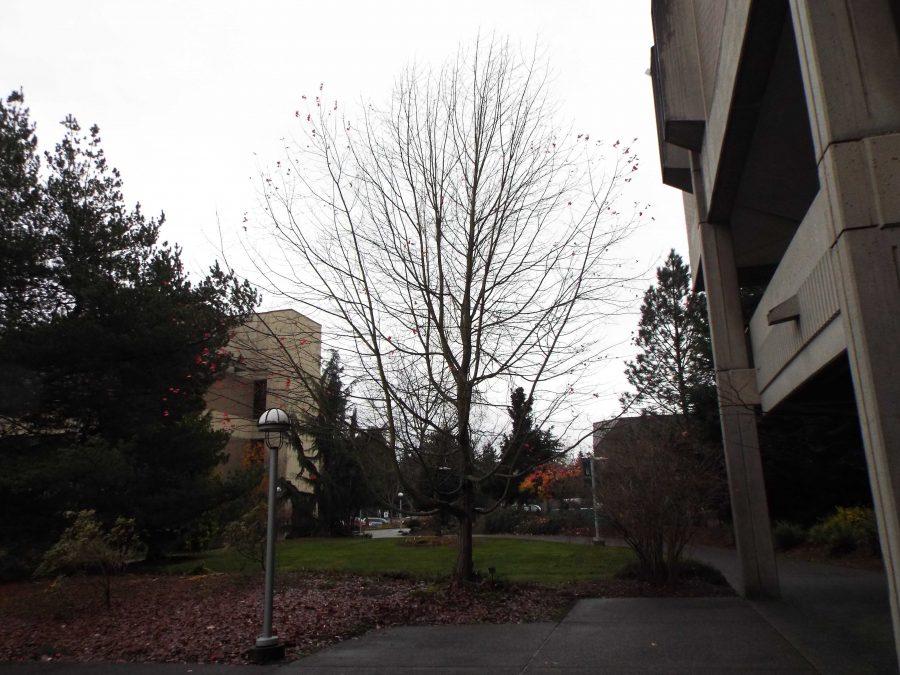Winter comes and goes, but October is here to stay
EdCC students and faculty connect with nature through education and service-learning
October Glory, or Acer rubrum, is located between Lynnwood, Mukilteo and Snohomish Halls. It is one of many trees around campus and Gold Park with an identifying plaque.
Anthropology Professor Dr. Thomas Murphy cares deeply about nature.
Recently, in Alderwood Hall with friends and colleagues Zachary Bigelow and Dave Beckham, he faced a question that hit home: Why does the connection between people and plants matter?
Dr. Murphy thought for a moment and silence filled the room before he answered. Finally, he leaned forward in his swiveling office chair and spoke.
“When you look at Grandmother Cedar, she was here before us.”
That idea of revered respect for nature, from the oldest cedar to the youngest rose, impacts all of Dr. Murphy’s work – from teaching EdCC anthropology classes to nature-based service learning activities and summer canoe trips with tribal elders.
“In fact,” he continued, “there were cedars here when the first Europeans came; they’re still here. They’re the same trees. Those trees actually have stories to tell. They don’t speak English – at least, not when I talk to them.”
He went on to explain how, if not through the English language, trees tell their stories. “Sometimes, those stories are written in their bark, in the shape of the tree,” Dr. Murphy said. “You have to learn to listen.”
Passion
One way Dr. Murphy teaches his anthropology students to listen is through summer canoe trips.
Local tribes make canoes out of cedarwood for the journey.
“When we’re harvesting that bark from the tree, the elders tell us … We have to ask permission of the tree,” Dr. Murphy said.
Elders also instruct students to give the tree an offering in exchange for its bark. For example, one student took soft cedar wood and shaped it into a small, beautiful rose.
“Culturally, when you stop and ask permission, it changes your relationship – it makes a much more stable relationship, regardless of whether the tree actually hears you or not,” Dr. Murphy said. “When that relationship is established, I care. I care what happens to that tree.”
Tree-huggers who shared this sentiment united to build the EdCC Cultural Kitchen (located on the Campus Community Farm).
Dr. Murphy recalls the story of each of the three trees used to build the kitchen, one donated from an Everett Community College colleague, another from a former student and member of the Snohomish Tribe, and the last from another student who wanted her tree to “have a new life.”
Dr. Murphy passed the remaining wood on to Dave Beckham, who enlisted his engineering students to design and construct chairs and workbenches of the remaining wood.
“It was a huge experience for them to give back to the community,” Beckham said.
Put together Native American elders and EdCC engineering students, and you have the potential to foster a positive relationship with nature.
“If you want to start a relationship with a person, what’s the first thing you do?” Dr. Murphy asked. “You introduce yourself, and you wanna know their name, right? So if you want a relationship with a plant, the first thing you gotta do is learn its name.
“Once we have that name, it changes the relationship. All of a sudden, it’s not just any old tree – it’s October Glory.”
Bigelow nodded in agreement. “I find comfort in knowing native plants because when I go out into the woods, I know it’s probably one of these maybe six or seven different things that I could be looking at,” he said.
Community
Even the general public harbors an inherent respect for nature, according to a study on landscape preferences conducted by Dr. Murphy’s anthropology class.
For the experiment, students went door-to-door in a local Edmonds neighborhood and showed the owners two pictures. One depicted a typical yard with short-cropped grass and a single small tree. The other displayed a similarly neat lawn, except this one included a colorful water garden. “We asked them, ‘Which of these two do you prefer?’” Dr. Murphy said. Nine out of ten people polled preferred the water garden, referencing its diversity and positive impact on the environment.
“People really have this deep connection to nature, even in the city,” Dr. Murphy said.
“If there are trees in a neighborhood, people feel safer. If there are trees in the yard of a house people are trying to sell, people will pay more for it.”
Whether they know it or not, people appreciate the presence of plants on a influential level.
“I personally love plants,” Bigelow added. “I work for the National Park Service during the summers and it has been really a huge joy in my life.
“Being able to look at something and understand it, you learn to get more out of the things that you’re looking at.”
Part of the appreciation anthropologists, Native Americans and treehuggers alike hold for nature stems from the understanding that interspecies relationships aren’t the only kinds of connections plants make.
“Plants, like us, have families. They have neighbors. They have friends. They have enemies,” Dr. Murphy said. “They will communicate to each other about us.”
Dr. Murphy explained how modern science discovered trees enjoy a better life when their mother tree lives.
Trees build these connections through mycelia, which can send and process chemical signals between plants.
“To me,” Dr. Murphy confided, “it’s a fascinating world.”
Education
Students and professors who share this love for nature use every means available to them to share that love.
“Having people coming in asking, ‘What is the plant I’m looking at?’ makes me pretty happy,” Bigelow said.
Dr. Murphy agreed. “This is a place where we celebrate the relationship between people and plants.”
Students can learn more about anthropology and why or how to appreciate nature on the EdCC website by visiting the stәĺĵxwáli: ‘Place of Medicine’ Ethnobotanical Garden page.
According to Bigelow, Campus Sustainability Club and plant plaques around EdCC are expressions of our anthropology and horticulture departments’ drive to bring appreciation of nature back into everyday student life.
Plaques in EdCC and Gold Park
One example of how environmentalists at EdCC strive to bring appreciation of nature into the student world is the numerous plaques denoting the name and species of particular plants around campus. The horticulture department worked in conjunction with EdCC Campus Grounds to create them, hoping to encourage student interest in nature.
“It all started with a tree that had a name,” Dr. Murphy laughed, referring to the plaques around EdCC campus.
“You have the name of the plants, their common name, which is the ‘October Glory’,” Bigelow explained. “Then you have the family that it’s in, which is the Aceraceae, according to the organization of species.”
This project extends beyond the EdCC campus.
“Have you seen the [plaques] in Gold Park?” Dr. Murphy asked. “We created what we call an ethnobotanical garden. We picked native plants… and we put signs on those. We have their names in English, Latin and the local native language.”
Going one step further, they worked with local tribes to not only learn native plant names, but also a few cultural uses of that species.
EdCC students can visit Gold Park located at 6421 200th St SW, Lynnwood, WA 98036.
Campus Sustainability Club
The EdCC Campus Sustainability Club (CSC) has worked with the college’s student resource center to provide activities and projects geared towards appreciating nature since 2007, arranging activities every quarter since 2009.
The CSC endeavors to share their love for nature with students on campus by allowing them to easily experience its wonder and grandeur.
The Campus Sustainability Club also hosts quarterly work parties at Gold Park to maintain its natural splendor. Elders from the Snohomish Tribe contribute traditional songs and stories from their culture about the plants.
Although most students can’t walk through a forest and name every tree, anyone can relearn to appreciate nature with a childlike wonder in everyday life.




